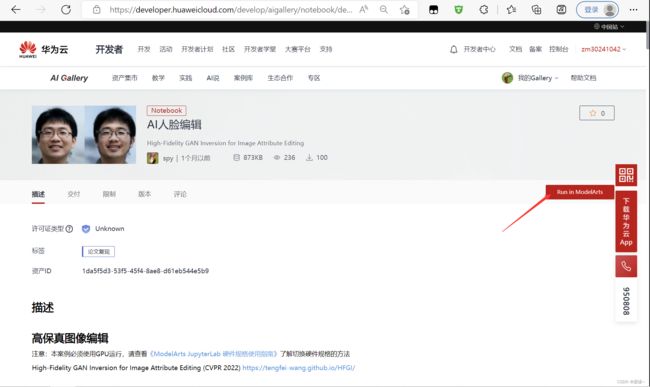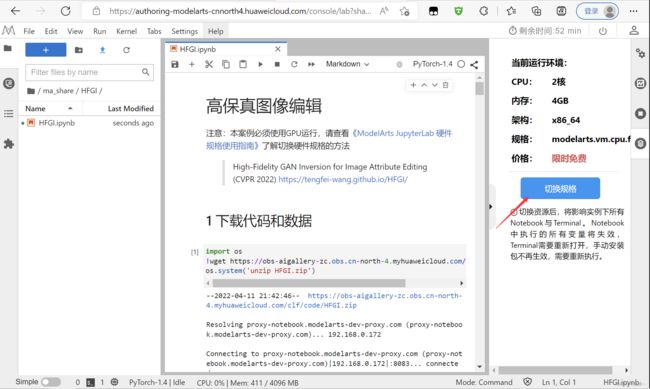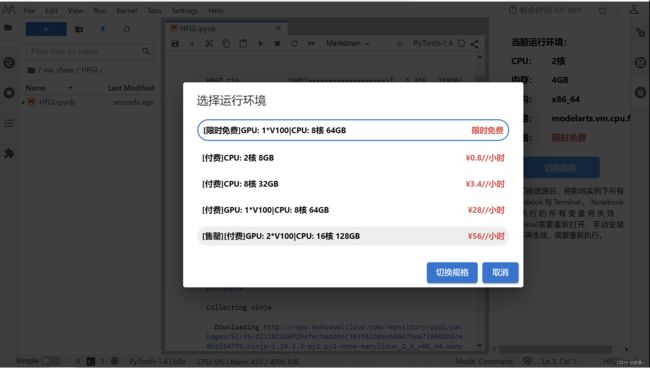华为云——AI人脸编辑让Lena微笑
目录
1.进入AI人脸编辑页面案例页面,并完成基础配置
2.下载代码和数据并安装依赖编辑
3.开始运行代码
1.进入AI人脸编辑页面案例页面,并完成基础配置
AI人脸编辑 (huaweicloud.com)
点击 Run in ModelArts,进入 JupyterLab 页面。
等待初始化
进行规格切换,并选择 [限时免费]GPU: 1*V100|CPU: 8核 64GB
点击右上角Select Kernel:选择PyTorch-1.4

2.下载代码和数据并安装依赖
安装依赖环境
!pip install ninja!pip install dlib!pip uninstall -y torch
!pip uninstall -y torchvision
!pip install torch==1.6.0
!pip install torchvision==0.7.0安装完成后,需要重启一下kernel,点击上方Restart the kernel
进入HFGI路径下:
%cd HFGI3.开始运行代码
#@title Setup Repository
import os
from argparse import Namespace
import time
import os
import sys
import numpy as np
from PIL import Image
import torch
import torchvision.transforms as transforms
# from utils.common import tensor2im
from models.psp import pSp # we use the pSp framework to load the e4e encoder.
%load_ext autoreload
%autoreload 2def tensor2im(var):
# var shape: (3, H, W)
var = var.cpu().detach().transpose(0, 2).transpose(0, 1).numpy()
var = ((var + 1) / 2)
var[var < 0] = 0
var[var > 1] = 1
var = var * 255
return Image.fromarray(var.astype('uint8'))加载预训练模型
model_path = "checkpoint/ckpt.pt"
ckpt = torch.load(model_path, map_location='cpu')
opts = ckpt['opts']
opts['is_train'] = False
opts['checkpoint_path'] = model_path
opts= Namespace(**opts)
net = pSp(opts)
net.eval()
net.cuda()
print('Model successfully loaded!')设置输入图像
# Setup required image transformations
EXPERIMENT_ARGS = {
"image_path": "test_imgs/Lina.jpg"
}
EXPERIMENT_ARGS['transform'] = transforms.Compose([
transforms.Resize((256, 256)),
transforms.ToTensor(),
transforms.Normalize([0.5, 0.5, 0.5], [0.5, 0.5, 0.5])])
resize_dims = (256, 256)将照片拖到此处即可上传
image_path = EXPERIMENT_ARGS["image_path"]
original_image = Image.open(image_path)
original_image = original_image.convert("RGB")
run_align = True图像对齐
import numpy as np
import PIL
import PIL.Image
import scipy
import scipy.ndimage
import dlib
def get_landmark(filepath, predictor):
"""get landmark with dlib
:return: np.array shape=(68, 2)
"""
detector = dlib.get_frontal_face_detector()
img = dlib.load_rgb_image(filepath)
dets = detector(img, 1)
for k, d in enumerate(dets):
shape = predictor(img, d)
t = list(shape.parts())
a = []
for tt in t:
a.append([tt.x, tt.y])
lm = np.array(a)
return lm
def align_face(filepath, predictor):
"""
:param filepath: str
:return: PIL Image
"""
lm = get_landmark(filepath, predictor)
lm_chin = lm[0: 17] # left-right
lm_eyebrow_left = lm[17: 22] # left-right
lm_eyebrow_right = lm[22: 27] # left-right
lm_nose = lm[27: 31] # top-down
lm_nostrils = lm[31: 36] # top-down
lm_eye_left = lm[36: 42] # left-clockwise
lm_eye_right = lm[42: 48] # left-clockwise
lm_mouth_outer = lm[48: 60] # left-clockwise
lm_mouth_inner = lm[60: 68] # left-clockwise
# Calculate auxiliary vectors.
eye_left = np.mean(lm_eye_left, axis=0)
eye_right = np.mean(lm_eye_right, axis=0)
eye_avg = (eye_left + eye_right) * 0.5
eye_to_eye = eye_right - eye_left
mouth_left = lm_mouth_outer[0]
mouth_right = lm_mouth_outer[6]
mouth_avg = (mouth_left + mouth_right) * 0.5
eye_to_mouth = mouth_avg - eye_avg
# Choose oriented crop rectangle.
x = eye_to_eye - np.flipud(eye_to_mouth) * [-1, 1]
x /= np.hypot(*x)
x *= max(np.hypot(*eye_to_eye) * 2.0, np.hypot(*eye_to_mouth) * 1.8)
y = np.flipud(x) * [-1, 1]
c = eye_avg + eye_to_mouth * 0.1
quad = np.stack([c - x - y, c - x + y, c + x + y, c + x - y])
qsize = np.hypot(*x) * 2
# read image
img = PIL.Image.open(filepath)
output_size = 256
transform_size = 256
enable_padding = True
# Shrink.
shrink = int(np.floor(qsize / output_size * 0.5))
if shrink > 1:
rsize = (int(np.rint(float(img.size[0]) / shrink)), int(np.rint(float(img.size[1]) / shrink)))
img = img.resize(rsize, PIL.Image.ANTIALIAS)
quad /= shrink
qsize /= shrink
# Crop.
border = max(int(np.rint(qsize * 0.1)), 3)
crop = (int(np.floor(min(quad[:, 0]))), int(np.floor(min(quad[:, 1]))), int(np.ceil(max(quad[:, 0]))),
int(np.ceil(max(quad[:, 1]))))
crop = (max(crop[0] - border, 0), max(crop[1] - border, 0), min(crop[2] + border, img.size[0]),
min(crop[3] + border, img.size[1]))
if crop[2] - crop[0] < img.size[0] or crop[3] - crop[1] < img.size[1]:
img = img.crop(crop)
quad -= crop[0:2]
# Pad.
pad = (int(np.floor(min(quad[:, 0]))), int(np.floor(min(quad[:, 1]))), int(np.ceil(max(quad[:, 0]))),
int(np.ceil(max(quad[:, 1]))))
pad = (max(-pad[0] + border, 0), max(-pad[1] + border, 0), max(pad[2] - img.size[0] + border, 0),
max(pad[3] - img.size[1] + border, 0))
if enable_padding and max(pad) > border - 4:
pad = np.maximum(pad, int(np.rint(qsize * 0.3)))
img = np.pad(np.float32(img), ((pad[1], pad[3]), (pad[0], pad[2]), (0, 0)), 'reflect')
h, w, _ = img.shape
y, x, _ = np.ogrid[:h, :w, :1]
mask = np.maximum(1.0 - np.minimum(np.float32(x) / pad[0], np.float32(w - 1 - x) / pad[2]),
1.0 - np.minimum(np.float32(y) / pad[1], np.float32(h - 1 - y) / pad[3]))
blur = qsize * 0.02
img += (scipy.ndimage.gaussian_filter(img, [blur, blur, 0]) - img) * np.clip(mask * 3.0 + 1.0, 0.0, 1.0)
img += (np.median(img, axis=(0, 1)) - img) * np.clip(mask, 0.0, 1.0)
img = PIL.Image.fromarray(np.uint8(np.clip(np.rint(img), 0, 255)), 'RGB')
quad += pad[:2]
# Transform.
img = img.transform((transform_size, transform_size), PIL.Image.QUAD, (quad + 0.5).flatten(), PIL.Image.BILINEAR)
if output_size < transform_size:
img = img.resize((output_size, output_size), PIL.Image.ANTIALIAS)
# Return aligned image.
return imgif 'shape_predictor_68_face_landmarks.dat' not in os.listdir():
# !wget http://dlib.net/files/shape_predictor_68_face_landmarks.dat.bz2
!bzip2 -dk shape_predictor_68_face_landmarks.dat.bz2
def run_alignment(image_path):
import dlib
predictor = dlib.shape_predictor("shape_predictor_68_face_landmarks.dat")
aligned_image = align_face(filepath=image_path, predictor=predictor)
print("Aligned image has shape: {}".format(aligned_image.size))
return aligned_image
if run_align:
input_image = run_alignment(image_path)
else:
input_image = original_image
input_image.resize(resize_dims)高保真逆向映射
def display_alongside_source_image(result_image, source_image):
res = np.concatenate([np.array(source_image.resize(resize_dims)),
np.array(result_image.resize(resize_dims))], axis=1)
return Image.fromarray(res)
def get_latents(net, x, is_cars=False):
codes = net.encoder(x)
if net.opts.start_from_latent_avg:
if codes.ndim == 2:
codes = codes + net.latent_avg.repeat(codes.shape[0], 1, 1)[:, 0, :]
else:
codes = codes + net.latent_avg.repeat(codes.shape[0], 1, 1)
if codes.shape[1] == 18 and is_cars:
codes = codes[:, :16, :]
return codes
with torch.no_grad():
x = transformed_image.unsqueeze(0).cuda()
tic = time.time()
latent_codes = get_latents(net, x)
# calculate the distortion map
imgs, _ = net.decoder([latent_codes[0].unsqueeze(0).cuda()],None, input_is_latent=True, randomize_noise=False, return_latents=True)
res = x - torch.nn.functional.interpolate(torch.clamp(imgs, -1., 1.), size=(256,256) , mode='bilinear')
# ADA
img_edit = torch.nn.functional.interpolate(torch.clamp(imgs, -1., 1.), size=(256,256) , mode='bilinear')
res_align = net.grid_align(torch.cat((res, img_edit ), 1))
# consultation fusion
conditions = net.residue(res_align)
result_image, _ = net.decoder([latent_codes],conditions, input_is_latent=True, randomize_noise=False, return_latents=True)
toc = time.time()
print('Inference took {:.4f} seconds.'.format(toc - tic))
# Display inversion:
display_alongside_source_image(tensor2im(result_image[0]), input_image)运行结果:
高保真图像编辑
from editings import latent_editor
editor = latent_editor.LatentEditor(net.decoder)
# interface-GAN
interfacegan_directions = {
'age': './editings/interfacegan_directions/age.pt',
'smile': './editings/interfacegan_directions/smile.pt' }
edit_direction = torch.load(interfacegan_directions['smile']).cuda()
edit_degree = 1.5 # 设置微笑幅度
img_edit, edit_latents = editor.apply_interfacegan(latent_codes[0].unsqueeze(0).cuda(), edit_direction, factor=edit_degree) # 设置微笑
# align the distortion map
img_edit = torch.nn.functional.interpolate(torch.clamp(img_edit, -1., 1.), size=(256,256) , mode='bilinear')
res_align = net.grid_align(torch.cat((res, img_edit ), 1))
# fusion
conditions = net.residue(res_align)
result, _ = net.decoder([edit_latents],conditions, input_is_latent=True, randomize_noise=False, return_latents=True)
result = torch.nn.functional.interpolate(result, size=(256,256) , mode='bilinear')
display_alongside_source_image(tensor2im(result[0]), input_image)运行结果:










